Find more information in the General Comments section of the assessment
Find more information in the Rating Validity tab of the assessment
- See More
- See More
- See More
- See More
- Good
- Adequate
- Marginal
- Weak
- Poor
 Passenger
Passenger
 Driver
Driver
 Rear Passenger
Rear Passenger
 Driver
Driver
 Car
Car
 Pole
Pole
 Rear Seat
Rear Seat
 Front Seat
Front Seat
- Good
- Adequate
- Marginal
- Weak
- Poor


Passenger
outboard
center
Fitted to the vehicle as standard
Not fitted to the test vehicle but available as option
Not Available
-
Infants up to 13 kg
-
Infants and toddlers up to 18 kg
-
Toddlers from 9 to 18 kg
-
Toddlers over 18 kg
Easy
Difficult
Safety critical
Not allowed
| Seat Position | ||||
|---|---|---|---|---|
| Front | 2nd row | |||
| Passenger | Left | center | Right | |
| Maxi Cosi Cabriofix (Belt) | ||||
| Britax Römer King Plus (Belt) | ||||
| Britax Römer Duo Plus (ISOFIX) | ||||
| Britax Römer KidFix (Belt) | ||||
| Maxi Cosi Cabriofix & EasyFix (Belt) | ||||
| Maxi Cosi Cabriofix & EasyFix (ISOFIX) | ||||
| BeSafe iZi Kid X3 ISOfix (ISOFIX) | ||||
| Maxi Cosi Pearl & Familyfix (ISOFIX) | ||||
| Britax Römer KidFix (ISOFIX) | ||||
Easy
Difficult
Safety critical
Not allowed
The Tucson scored maximum points in the dynamic crash tests for its protection of the 1½ year dummy. Chest accelerations of the 3 year dummy, sat in a forward facing restraint, were marginally elevated but, otherwise, protection was good. The front passenger airbag can be disabled to allow a rearward-facing child restraint to be used in that seating position. Clear information is provided to the driver regarding the status of the airbag and the system was rewarded. All of the child restraint types for which the Tucson is designed could be properly installed and accommodated in the car.
- Good
- Adequate
- Marginal
- Weak
- Poor

Head Impact 19.6 Pts
Pelvis Impact 0.2 Pts
Leg Impact 6.0 Pts
The Tucson has a deployable bonnet for increased pedestrian protection. Sensors in the bumper detect when a pedestrian has been struck and actuators lift the bonnet, providing greater clearance between the surface and the hard structures in the engine compartment. Hyundai showed that the system worked robustly for a variety of pedestrian statures and over a wide range of speeds. Accordingly, the bonnet was tested in the deployed (raised) position and performed well, showing good protection at almost all test points. Protection of the pelvic region was predominantly poor while the bumper provided mostly good protection to pedestrians' legs.
- Good
- Adequate
- Marginal
- Weak
- Poor
| Speed Limit Information Function | Camera & Map |
| Warning Function | Manually set |
| Speed Limitation Function | Manually set |
| System Name | ESC | |
| Performance | ||
| Vehicle Yaw Rate @ COS + 1.00 s | 1.15% | meets ECE requirements |
| Vehicle Yaw Rate @ COS + 1.75 s | 1.27% | meets ECE requirements |
| Lateral Displacement @ BOS + 1.07 s | 2.73 m | meets ECE requirements |
| Applies To | All seats | ||
| Warning | Driver Seat | Front Passenger(s) | Rear Passenger(s) |
| Visual | |||
| Audible | |||
|
|||
| System Name | LDWS |
| Type | Lane Departure Warning |
| Operational From | 60 km/h |
| Warning | Audible & Visual |
| Performance | |
|
LDW Confirmation Test
|
Pass |
Electronic stability control is standard equipment on the Tucson as is a seatbelt reminder system for the front and rear seats. A lane departure warning system is an option which is expected to be broadly fitted and was included in the assessment. Also optional but qualifying for assessment is a speed assistance system consists of a camera-based speed recognition, informing the driver of the local speed limit, and a speed limiter which the driver can set appropriately. An autonomous emergency braking system is available as an option but is not expected to be sold in sufficient numbers to qualify for assessment here.
- Specifications
- Safety Equipment
- Videos
- Rating Validity
Specifications
Tested Model Hyundai Tucson 1.7 diesel GLS 4x2, LHD
Body Type - 5 door wagon
Year Of Publication 2015
Kerb Weight 1494kg
VIN From Which Rating Applies - all petrol and diesel engined Tucsons, 4x4 and 4x2
Class Small SUV
Safety Equipment
Note: Other equipment may be available on the vehicle but was not considered in the test year.
Fitted to the vehicle as standard
Fitted to the vehicle as option
Not fitted to the test vehicle but available as option
Not Available
Not Applicable
Videos
Rating Validity








Find more information in the General Comments section of the assessment
 Share
Share
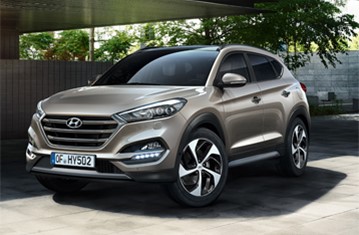


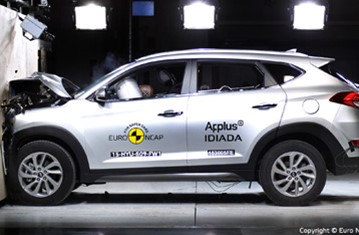

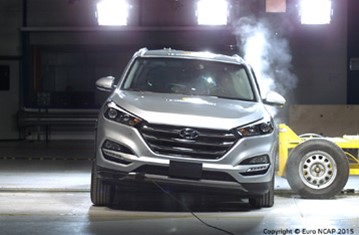

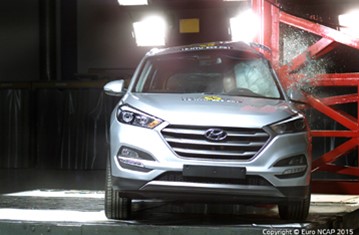
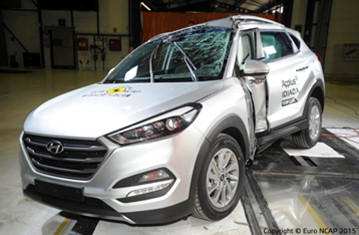



The passenger compartment remained stable in the offset frontal impact. Dummy readings indicated good protection of the knees and femurs of the driver and passenger dummies. Hyundai showed that a similar level of protection would be provided to occupants of different sizes and to those sat in different positions. For the passenger dummy, protection of all other body regions was also rated as good. In the full-width rigid barrier test, protection of both dummies was good apart from the chest, protection of which was adequate for the front driver and marginal for the rear passenger. In the side barrier impact, protection of all critical body areas was good and the Tucson scored maximum points. However, in the more severe side pole test, dummy readings of rib compression indicated marginal protection of the chest, other critical body regions being well protected. Tests on the front seats and head restraints showed good protection against whiplash injury in the event of a rear-end collision and a geometric assessment indicated the same for rear seat passengers. An autonomous emergency braking system is available which operates from the low speeds typical of city driving at which many whiplash accidents occur. As the system is not standard equipment it was not included in this assessment.